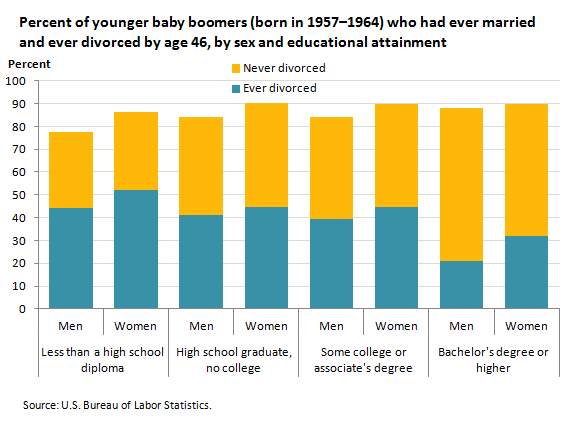An official website of the United States government
 United States Department of Labor
United States Department of Labor
Eighty-seven percent of baby boomers born in the years 1957–1964 had married at least once by the time they reached age 46. Of those who had married, 45 percent had experienced at least one divorce. There were some notable differences in marriage and divorce patterns between men and women and among educational attainment groups.

| Sex and educational attainment | Ever married | Ever divorced | Never divorced |
|---|---|---|---|
Men, total | 84.3 | 36.0 | 48.3 |
Less than a high school diploma | 77.5 | 44.4 | 33.1 |
High school graduate, no college | 84.2 | 41.2 | 43.0 |
Some college or associate's degree | 84.3 | 39.5 | 44.8 |
Bachelor's degree or higher | 88.0 | 20.9 | 67.1 |
Women, total | 89.5 | 42.0 | 47.5 |
Less than a high school diploma | 86.2 | 52.3 | 33.9 |
High school graduate, no college | 90.3 | 44.5 | 45.8 |
Some college or associate's degree | 89.6 | 44.7 | 44.9 |
Bachelor's degree or higher | 89.9 | 32.0 | 57.9 |
Men and women with at least a bachelor’s degree were about equally likely to marry by age 46 (90 percent and 88 percent, respectively). At all lower levels of education, women were more likely than men to marry.
Men with at least a bachelor’s degree were about 11 percentage points more likely to have married by age 46 than were men who did not complete high school. Among women, the likelihood to marry varied less by educational attainment; female college graduates were only about 4 percentage points more likely to have married than were women who did not complete high school.
For both men and women who had married, those with a bachelor’s degree were much less likely to have divorced than were men and women with less education. The differences were larger for men than for women, however. Among men who had married, those who had not completed high school were more than twice as likely to have divorced as those who had completed at least a bachelor’s degree. This difference was roughly half as large among women.
These data are from the National Longitudinal Surveys program. To learn more, see “Marriage and divorce: patterns by gender, race, and educational attainment,” by Alison Aughinbaugh, Omar Robles, and Hugette Sun in the Monthly Labor Review, October 2013. The article examines the marital histories of men and women in the National Longitudinal Survey of Youth 1979. These men and women were born in the years 1957 to 1964 and lived in the United States when the survey began in 1979.
Bureau of Labor Statistics, U.S. Department of Labor, The Economics Daily, Marriage and divorce rates among baby boomers vary by educational attainment at https://www.bls.gov/opub/ted/2013/ted_20131108.htm (visited April 23, 2024).

